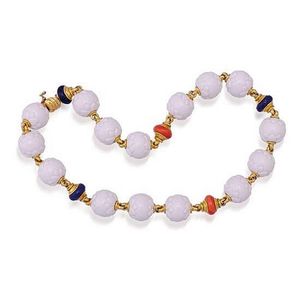Bulgari Chandra Necklace with Coral and Lapis Lazuli
You must be a subscriber, and be logged in to view price and dealer details.
Subscribe Now to view actual auction price for this item
When you subscribe, you have the option of setting the currency in which to display prices to $Au, $US, $NZ or Stg.
- Assay / Assayed - Assaying is the testing of a metal, most commonly silver and gold to determine its ingredients and quality. In Britain, once an item of silver or gold has been assayed, a mark is stamped on it, certifying its purity. Known as hallmark, it derives its name from the Guild Hall of the Goldsmiths' Company, who recieved its Charter in 1327 giving it the power to assay and mark articles of gold and silver.
- Lapis Lazuli - Lapis lazuli is a semi-precious deep blue coloured stone, sometimes with gold inclusions, that has been used for thousands of years for jewellery, decorative items and decoration.
It is mined in Afghanistan, Siberia, Chile, USA and Burma. The mines in north-eastern Afghanistan are the largest source of lapis lazuli, and have been operating for over 6,000 years.
They were the source of the stone for the ancient Egyptian, Greek and Roman civilsations. - Circa - A Latin term meaning 'about', often used in the antique trade to give an approximate date for the piece, usually considered to be five years on either side of the circa year. Thus, circa 1900 means the piece was made about 1900, probably between 1895 and 1905. The expression is sometimes abbreviated to c.1900.
- Coral - Coral used in jewellery. Coral is a material that is commonly used in jewellery making. It is made up of the skeletons of tiny marine animals called coral polyps. There are many species of coral, but only one group, Corallium, is suitable for carving, and thus can be used in jewellery manufacture. These have a deep red or pink orange skeleton and are known as "noble coral" or "precious coral".
This item has been included into following indexes:
Visually similar items

A strand of forty nine aquamarine bead necklace round in shape, 12 mm, pale blue in colour

Graduated aquamarine necklace, size: 46 cm length

A cultured pearl necklace, composed of thirty-three graduated baroque South Sea pearls of alternating white and golden hues, measuring approximately 14.6-10.9 mm, with diamond-set bi-coloured gold ball clasp of satin finish, mounted in 18 carat yellow and

South sea pearl necklace, composed of thirty-one cultured pearls graduating in size from 13.05 to 16.60 mm completed by an 18ct white gold and diamond clasp, length approximately 430 mm.
